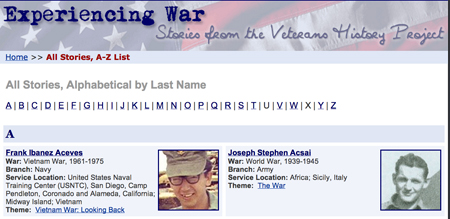Analyzing Primary Sources: Learning from Oral Histories

History textbooks give overviews of people and events of the past. Primary sources provide varied perspectives, adding details, nuance and, often, a sense of immediacy that make history come alive. Oral histories and personal narratives allow us to step into someone else’s shoes for a moment and make personal connections to history. Students who completed the TPS-Barat Digital Stories of Our Heroes project, described the difference between learning from a textbook and learning from an oral history as “going from black and white to color” and “it’s like looking at a picture of the ocean and then being at the ocean”.
The analysis of primary source oral histories aligns to the Common Core Reading Anchor Standard 7 / Speaking & Listening Anchor Standard 2—Integrate and evaluate content / information presented in diverse media and formats, including visually and quantitatively, as well as in words.
To help analyze oral histories, you can have students use the Library’s primary source analysis tool and the list of guiding questions provided below, which were adapted from this list.
Oral History Analysis Guiding Questions
OBSERVE: Identify and note details
- What type of oral history is this (audio recording, video, written transcript)?
- Where is the recording taking place?
- Is the content easy or difficult to understand because of vocabulary or accent? If this is an audio or video recording, describe any background sounds or special effects you hear in addition to the voice.
- What is the topic or theme of the oral history?
- Who helped make this oral history? Does it seem like an interview or a conversation? Is there any evidence of a personal relationship between the person providing the oral history and the person(s) capturing the history?
- Are there details that suggest the time period this oral history relates to? Is the creation date listed in the bibliographic record? If the creation date is listed, was this oral history created at or around the same time period the content relates to?
- What other details do you notice when reading, listening to or viewing this oral history?
REFLECT: Generate and test hypotheses
- What tone does/do the speaker/speakers have? How does the tone affect the feeling or mood of the oral history?
- If background noises or special effects are present, how do they affect the feeling or mood of the oral history?
- Why do you think this oral history was captured? What might have been the purpose of capturing this history? What evidence supports your theory?
- Who do you think was the audience for this oral history?
- What do you think the person providing and the person(s) capturing the history might have wanted the audience to think or feel?
- How did you feel during and after reading, listening to or viewing this oral history?
- What bias does the person providing the oral history show? Do you detect bias in presentation of this oral history? Is so, towards whom or what?
- What was happening during the time period this oral history represents? If someone were talking about this topic or theme today, what would be different/the same?
- What did you learn from this oral history? Does any new information you learned contradict or support your prior knowledge about this topic?
QUESTION: What didn’t you learn that you would like to know about? What questions does this oral history raise? What do you wonder about . . .
- Who?
- What?
- When?
- Where?
- Why?
- How?
What sources might you consult to learn more?
Please feel free to download and distribute the Oral History Analysis Guiding Questions document and the primary source analysis tool (but please keep the formats, including logos, intact).
- Analyzing Primary Sources: Learning from Audio Recordings
- Analyzing Primary Sources: Learning from Images
- Analyzing Primary Sources: Learning from Maps
- Analyzing Primary Sources: Learning from Music
- Analyzing Primary Sources: Learning from Newspapers
- Analyzing Primary Sources: Learning from Political Cartoons
- Analyzing Primary Sources: Learning from Texts
- Analyzing Primary Sources: Learning from Video Recordings
Related resources
